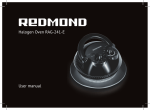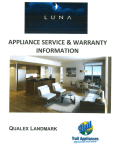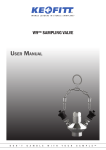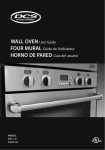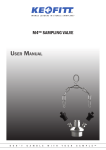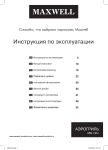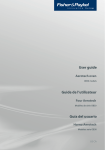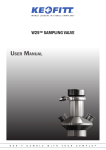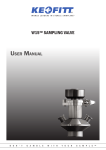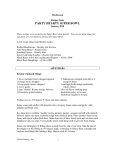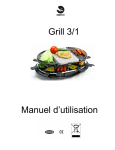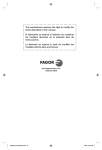Download Fisher & Paykel - Appliances Online
Transcript
Aerotech oven User guide OB76models NZ AU Contents Safety and warnings Introduction Using your oven - before you start Setting the clock Using the oven controls Oven functions Using your oven Positioning the shelves Choosing the right bakeware Selecting function and temperature Preheating your oven Using the oven functions Using the meat probe Automatic cooking Cooking guidelines Care and cleaning User preference settings Troubleshooting Warranty and service Important! SAVE THESE INSTRUCTIONS The models shown in this user guide may not be available in all markets and are subject to change at any time. For current details about model and specification availability in your country, please visit our local website listed on the back cover or contact your local Fisher & Paykel dealer. 1 2 5 6 7 8 10 11 12 12 13 16 18 20 28 32 35 37 2 Safety and warnings Operation Your oven has been carefully designed to operate safely during normal cooking procedures. Please keep the following guidelines in mind when you are using your oven: WARNING! Electrical Shock Hazard Turn the oven off at the wall before replacing fuses or the oven lamp. Failure to do so may result in death or electrical shock. WARNING! Hot Surface Hazard Accessible parts may become hot when in use. To avoid burns and scalds, keep children away. Use oven mitts or other protection when handling hot surfaces such as oven shelves or dishes. Use care when opening the oven door. Let hot air or steam escape before removing or replacing food. Do not touch heating elements or interior surfaces of the oven. Heating elements may be hot even though they are dark in colour. Interior surfaces of an oven become hot enough to cause burns. During and after use, do not touch, or let clothing or other flammable materials contact heating elements or interior surfaces of the oven until they have had sufficient time to cool. Other surfaces of the appliance may become hot enough to cause burns among these surfaces are the oven vent, the surface near the oven vent, and the oven door and window, which could also become hot enough to cause burns. Failure to follow this advice could result in burns and scalds. Safety and warnings 3 Important safety instructions To reduce the risk of fire, electrical shock, injury to persons, or damage when using the oven, follow the important safety precautions listed below: Read all the instructions before using the oven. Use the oven only for its intended purpose as described in these instructions. Proper installation: be sure your appliance is properly installed and earthed by a qualified technician. Isolating switch: make sure this oven is connected to a circuit which incorporates an isolating switch providing full disconnection from the power supply. Never use your appliance for warming or heating the room. Persons could be burned or injured or a fire could start. Household appliances are not intended to be played with by children. Do not leave children alone. Children should not be left alone or unattended in the area where the appliance is in use. They should never be allowed to sit or stand on any part of the appliance. Children or persons with a disability which limits their ability to use the appliance, should have a responsible person to instruct them in its use. The instructor should be satisfied that they can use the appliance without danger to themselves or their surroundings. Do not place heavy objects on the oven door. Wear proper apparel. Do not wear loose fitting or hanging garments when using the appliance. They could ignite or melt if they touch an element or hot surface and you could be burned. User servicing: do not repair or replace any part of the appliance unless specifically recommended in the manual. All other servicing should be referred to a qualified technician. Storage in or on appliance: flammable materials should not be stored in an oven or near its surface. Do not use water on grease fires. Smother the fire or flame or use a dry chemical or foam type extinguisher. Use only dry oven mitts or potholders. Moist or damp potholders on hot surfaces could result in burns from steam. Do not let potholders touch hot areas or heating elements. Do not use a towel or a bulky cloth for a potholder. It could catch fire. Do not heat unopened food containers. They can build up pressure that may cause the container to burst and result in injury. Safe food handling: leave food in the oven for as short a time as possible before and after cooking. This is to avoid contamination by organisms which may cause food poisoning. Take particular care during warm weather. Always keep oven vents unobstructed. Caution. Hot air can blow from the vent at the base of the oven as part of the oven’s cooling system. Do not place aluminium foil, dishes, trays, water or ice on the oven floor during cooking, as this will irreversibly damage the enamel. 4 Safety and warnings Placement of oven racks (shelves): always position racks (shelves) in the desired location while the oven is cool (before preheating). If a rack (shelf) must be removed while the oven is hot, do not let the oven mitts or potholder contact hot heating elements in the oven or the base of the oven. Do not clean the door seal or cavity seals (gaskets) or use any oven-cleaning products on them. They are essential for a good seal, which ensures that the oven operates efficiently. Care should be taken not to rub, damage or move them. Do not use oven cleaners, harsh/abrasive cleaning agents, waxes, or polishes. No commercial oven cleaner, oven liner, or protective coating of any kind should be used in or around any part of the oven. Do not use harsh/abrasive cleaners, scourers or sharp metal scrapers to clean the oven door glass since they scratch the surface, which may result in the glass shattering. Clean only the parts listed in this manual. Do not use a steam cleaner to clean any part of the oven. Before starting a self-clean cycle, remove oven shelves/racks, side racks/shelf supports, griller pan and all other cookware/utensils, and wipe up large food spills or grease deposits. During a self-clean cycle, the oven reaches higher temperatures than it does for cooking. Under such conditions, the surfaces may get hotter than usual and children should be kept away. Do not store things children might want above the oven. Children could be burned or injured while climbing on the oven to retrieve items. Do not install or operate the appliance if it is damaged or not working properly. If you receive a damaged product, contact your dealer or installer immediately. Use only bakeware approved for oven use. Follow the bakeware manufacturer’s instructions. Introduction 5 About your new oven Thank you for buying a Fisher & Paykel built-in multifunctional oven. Now that it is installed and ready to use, you will want to know everything about it to make sure you get excellent results right from the start. This guide introduces you to all its features, as well as giving you a set of cooking guidelines. We recommend you read the entire guide before using your new oven, for both safety and for cooking success. 11 6 1 7 2 9 12 3 13 10 14 4 15 15 8 5 16 Cavity seal (gasket) 1 Control panel 9 2 Door handle 10 Top element 3 Oven window 11 Oven lights 4 Upper oven 12 Meat probe socket 5 Lower oven (double models only) 13 Convection fan & concealed element 6 Model & serial number 14 Lower concealed element 7 Self-clean latch 15 Door hinge 8 Door seal (gasket) 16 Oven vent 6 Using your oven - before you start Setting the clock When your oven is connected to a power supply for the first time, a tone will sound and the clock display will light up. The clock display will show ‘12:00’ and the colon ( : ) will flash. Next, set the clock. Important! You must set the clock before you can use the oven. To set the clock 1 2 TO While the colon (:) is flashing, rotate the PUSH button until the correct time is showing. CLEAR Press the CLOCK button to set the time, or wait eight seconds and it will set automatically. Refer to ‘User preference settings’ for instructions on how to change between 12-hour and 24hour display. a Clock display a b C L O C K button - allows you to set the clock c PUSH TO CLEAR - turn this button to set the clock, timer, probe temperature, cook time, stop time b c - press this button to clear the display Using your oven - before you start 7 Using the oven controls In double ovens, knobs on the left are for the upper oven and knobs on the right are for the lower oven. Pushing the oven cavity selector button lets you toggle between the oven cavities, for example if you are setting automatic programs. g a TIMER button b COOK TIME button i c STOP TIME button d PROBE button h e CLOCK button f PUSH TO CLEAR button (rotate/press) g Upper oven cavity display h Lower oven cavity display i Oven cavity selector button - press this a b c d e f button to toggle between upper and lower cavity settings g, h, and i are on double models only Timer You can use the timer at any time, even when you are not using the oven. 1 2 3 4 To set the timer Press the TIMER button. The TIMER symbol and the colon will flash in the clock display. Rotate the PUSH TO button until you have the time you need. Press the TIMER button or wait CLEAR eight seconds for the setting to be adopted and the timer will begin to count down. To cancel the timer, press the TIMER button then the PUSH TO button. CLEAR When the set time finishes, the TIMER symbol and 0:00 will flash and the oven will beep. Press the TIMER or PUSH TO button to stop the beeping and clear the timer. CLEAR The timer does not turn the oven off. 8 Using your oven - before you start Oven Functions BAKING TRUE AERO: fan plus fan element A concealed heating element surrounding the fan in the rear of the oven heats air, which is then blown into the cavity. The consistent temperature ensures baking is well risen and evenly coloured. Cookies are crisp on the outside and chewy in the middle, meat and poultry are deliciously browned and sizzling while remaining juicy and tender. Casseroles are cooked to perfection and reheating is quick and efficient. TRUE AERO is the function to choose for multi-shelf cooking and complete oven meals. AERO BAKE: fan plus upper and lower elements The oven fan circulates hot air from the top outer and the lower concealed elements and distributes it around the oven cavity. Food cooked using the AERO BAKE function tends to brown more quickly than foods cooked on the traditional BAKE function. Use AERO BAKE at a low temperature – 50°C– for drying fruit, vegetables and herbs. BAKE: upper and lower elements Heat comes from the top outer and lower concealed elements. BAKE is the traditional baking function, ideal for cakes. If baking on two shelves, arrange dishes so no item is directly over another. BAKE is ideal for foods that require baking for a long time or at low temperatures, like meringues and rich fruitcakes. AERO PASTRY: fan plus lower element The fan circulates heat from the lower concealed element throughout the oven. Excellent for sweet and savoury pastry foods, for moist breads and brownies and cookies that you want extra chewy. PASTRY BAKE: lower element Heat comes from the lower element only. This is a traditional baking function, suitable for recipes that were developed in older ovens. For best results, bake on only one shelf at a time. It is perfect for foods that require delicate baking and have a pastry base, like custard tarts, pies, quiches and cheesecake or anything that does not require direct heat and browning on the top. ROASTING ROAST This is a two-step program. The oven does not require preheating. An initial 20minute searing stage crisps and browns the roast and caramelises the juices on the outside of the meat , then the temperature drops to the level you have preset for the remainder of the cooking period, producing a tender and juicy roast that is full of flavour. This function is also great for cooking vegetables. Little browning takes place after the initial searing. Using your oven - before you start 9 GRILLING GRILL: upper inner element GRILL delivers intense heat from the inner region of the top element. Great when you need to quickly grill one to two portions of your usual favourites, like crispy chicken breasts or a steak. MAXI GRILL: upper inner and outer elements MAXI GRILL delivers intense heat from the entire top element. It is the most suitable function for ‘finishing off’ many meals, for example browning the top of potato gratin and frittata. Use MAXI GRILL to toast bread or to grill your favourite chicken, fish and steak. AERO GRILL: fan plus upper inner and outer elements AERO GRILL produces food with a finish that is similar to a rotisserie. Meat, poultry and vegetables cook beautifully; food is crisp and brown on the outside while the inside remains moist and tender. Try using this function for whole chicken or tenderloin of beef. WARM WARM is a constant low heat of 75°C. Use it to keep cooked food hot, or to warm plates and serving dishes. To reheat food from cold, use TRUE AERO and change to WARM only when the food is piping hot, as this function will not bring cold food up to a temperature high enough to kill any harmful bacteria. SELF CLEAN This oven features a pyrolytic self-cleaning cycle that takes care of the mess and grime that is traditionally associated with oven cleaning. During self-cleaning, the oven reaches very high temperatures. This burns off and breaks down soil and grease deposits. A smoke eliminator and active venting system eradicates odour. For instructions on how to use SELF CLEAN, see the ‘Care and cleaning’ section. Cooling fan A cooling fan will come on automatically and blow air out below the oven door during the use of most oven functions. It may continue to run after the oven is turned off to keep the door and control panel cool. 10 Using your oven Positioning the shelves 8 7 6 5 4 3 2 1 Placing the telescopic sliding shelves on the side racks provides eight cooking positions to choose from. See the ‘Cooking guidelines’ for suggested shelf positions. To position the shelves Always position oven shelves BEFORE heating the oven. To remove a sliding shelf, grip it by its two front corners (making sure you are gripping the wire shelf and the sliding frame together), tilt upwards and pull it out of the oven. To place a sliding shelf in the oven correctly, position it so that the front bar is toward you, as shown. Check that the sliding frame is not extended. Check the guard rail (as shown) to make sure the shelf is the right way up. Position the shelf so that it is level and the rear shelf tags on both sides of the sliding frame rest on the side racks (as shown). Then push the sliding shelf all the way to the back of the oven, until the front shelf tags drop into place. Note: generally, the shelf positions in the top of the oven are suitable for grilling. Those in the middle or lower region of the oven are suitable for baking, roasting and casseroles. For your safety, the wire shelves and telescopic sliding frames are built together as one unit and are not separable. This means that when placed properly on the side racks, the slides will prevent the wire shelves from tilting when pulled towards you. To prevent the tags from lifting off the side racks, take care to slide the shelves forward horizontally. Guard rail Mounting slots Side rack Side rack Lock stud Wire shelf Shelf tag Sliding frame (push fully into place) Front bar Retaining wire Using your oven 11 Choosing the right bakeware The size, shape and material of the bakeware will affect the baking time. Rack The three-piece grill/roast system provided with your oven (consisting of the pan, grid and rack) has been designed to reduce splatter and smoke, and is therefore Grid ideal for grilling and roasting. We suggest you place meat on the grill/roast rack (on top of the pan and grid) to allow hot air to circulate around it. This gives more even browning and a result similar to a rotisserie. Pan On occasions, you may want to use only two pieces of the system. For example, when roasting a large turkey, use only the pan and grid for greater stability. Metal bakeware results in the fastest baking time. Dark baking pans or those with a dull finish absorb heat or brown food, especially on the base, faster than shiny pans. A shiny finish may work best for some cakes and cookies, as it reflects some heat and gives a less intensive baking surface. If using dark baking pans, it may be necessary to reduce the oven temperature by 10°C. It may also be necessary to extend the baking time by a couple of minutes. Insulated cookie sheets or baking pans may increase the length of baking time. Use glass or ceramic bakeware for foods that do not require a dark brown crust (eg soufflé or lasagna). 12 Using your oven Selecting function and temperature To select a function, turn the function knob. To select a temperature, turn the temperature knob clockwise. For double ovens, knobs on the left are for the upper oven and knobs on the right are for the lower oven. See the ‘Cooking guidelines’ section for suggested functions and temperatures. Preheating your oven 1 2 3 Preheat your oven when using the following functions for baking: TRUE AERO, AERO BAKE, BAKE, AERO PASTRY and PASTRY BAKE. These functions are equipped with a fast preheat: the oven will heat to 175°C in approximately 10 minutes and to 225°C in approximately 15 minutes. When your oven is preheating, the selected temperature is displayed alternately with the actual oven temperature. When the oven reaches the selected temperature, a beep will sound and the illuminated ring around the temperature knob will change from red to white. If you want to increase the oven temperature during cooking, follow these steps to reactivate the fast preheat: Turn the function and temperature knobs to OFF. Wait for the display lights to go out. Then select the new settings. Using your oven 13 Using the oven functions Baking For best results when baking, always preheat the oven to the temperature recommended in the recipe. Make sure cake pans do not touch each other or the sides of the oven by staggering them across shelves. If using the BAKE function and baking on more than one shelf (eg layer cakes), stagger the cake pans so one is not directly above another. TRUE AERO is good for multi-shelf baking as the temperature inside the cavity is even. Do not open the oven door until at least ¾ through the suggested baking time. When baking double the recipe, especially cookies, it may be necessary to increase the baking time by a couple of minutes. The circulating air of convection (AERO) functions heats and browns foods more quickly than using non-convection functions. When converting recipes from BAKE to AERO BAKE, the oven temperature can normally be lowered by 10°C; the baking time will remain the same. For some recipes, it may work better to reduce the baking time by several minutes and leave the oven temperature unchanged. For recipes with longer baketimes (ie over an hour), best results may be achieved by reducing both slightly. Food flavours and smells will not transfer between different foods cooked using convection functions. As a general rule, TRUE AERO is excellent for turkeys and baking foods on multiple shelves; AERO BAKE browns dishes well and is ideal for dishes cooked in under an hour; BAKE is generally the function to choose for delicate foods and those in the oven for longer than an hour. Important! Do not place aluminium foil, dishes with reflective qualities or any object on the oven floor as this will cause a heat build-up which will irreversibly damage the enamel. 14 Using your oven Roasting Using the ROAST function will give you a tender and juicy roast that is full of flavour. Place the meat on the grill/roast system on a shelf so that the top of the roast is in the centre of the oven or lower. Tender cuts should be cooked at a high temperature quickly, while tougher cuts require a lower temperature for a longer time. Use the meat probe for perfect results – it takes the guesswork out of telling when your roast is done. See the instructions on ‘Using the meat probe’. Thick pieces of meat take longer to cook than thin pieces of the same weight. Boneless, rolled or stuffed roasts take longer to cook than roasts containing bones. Poultry should always be well cooked with the juices running clear at an internal temperature of 75°C. Roasting uses dry heat. Don’t add water to your roast as this has a steaming effect. Vegetables are excellent cooked on ROAST. You can also place them around meat on the grill/ roast system. Do this partway through cooking a large piece of meat which takes longer than two hours to cook, so that you do not overcook the vegetables. Note that the vegetables will brown and cook more slowly if they have missed the initial searing stage. In ROAST function, the initial searing is too hot for roasting bags. Use TRUE AERO, AERO BAKE or BAKE if you are using roasting or oven bags and follow the manufacturer’s guidelines. Grilling Using the GRILL, MAXI GRILL and AERO GRILL functions gives you a healthier alternative to frying. It is also a great way to cook vegetables. AERO GRILL is especially suitable for foods that you might normally pan-fry, barbecue or rotisserie. Always grill with the oven door completely closed. Note that power levels are expressed as a percentage from LO (50% power) to HI (100% power) in GRILL and MAXI GRILL functions. Most grilling is carried out on HI, but you may want to reduce the heat to suit your needs. We recommend that you place food on the three-piece grill/roast system. In GRILL and MAXI GRILL, best results may be achieved by preheating the griller for about five minutes before you begin cooking. If you use glass or ceramic dishes and pans, be sure that they can withstand the high temperature of the grill. To prevent food sticking, spray the grid with a light coating of non-stick cooking spray. To avoid piercing the meat and letting juices escape, use tongs or a spatula when you turn the meat halfway through the cooking time. Using your oven 15 Tips for dehydrating fruit To obtain high quality dried fruit, select only unblemished, ripe fruit. Wash fruit thoroughly and pat dry. Peel if desired. Fruit that is not peeled will take longer to dry. Remove pits, stems or seeds if necessary. Place fruit on a baking tray on a shelf in the oven. We recommend using TRUE AERO or AERO BAKE at 50°C. Tips for proofing bread Your oven provides an ideal sealed environment for proofing bread. Preheat the oven on BAKE at 30°C. When you are ready to proof the dough, turn the temperature OFF, leaving the function knob at BAKE, and place the dough in a covered bowl on a shelf in the warm oven. It will be the perfect temperature to proof dough. The oven is so well insulated that it will stay warm for several hours. Note: some recipes recommend putting water or ice in the oven with the bread dough during baking. The additional moisture improves the bread crust. You must place the water or ice in a heat resistant dish and on an oven shelf in positions 1 or 2. Do not put it directly onto the oven floor. Placing water, ice or any dish or tray directly on the oven floor will irreversibly damage the enamel. 16 Using your oven Using the meat probe Use your meat probe to accurately judge when your meat is perfectly cooked. You can use the probe on TRUE AERO, AERO BAKE, ROAST, AERO GRILL and BAKE functions. 1 2 3 4 5 6 7 8 9 Select the oven function and temperature. Preheat the oven if d a appropriate. Remember ROAST and AERO GRILL do not require preheating. b Insert the metal probe horizontally into the centre of the c thickest part of the fully defrosted meat. The thicker the meat, the longer it will take to cook, so it is important that the probe is measuring the temperature of the meat at its thickest point. Make sure the probe does not touch bone (pull c probe away from bone 1.5 cm), fat or gristle, as these will heat up more quickly than the lean meat. Place the meat on the grill/roast system. a Metal probe c Handle When the oven has preheated (if required) to the set b Plug d Cable temperature, place the grill/roast system in the oven and insert the plug end of the meat probe into the probe socket, using an oven mitt if the oven is hot. The probe socket is on the left hand side of the oven, just under shelf position 7. Make sure the probe is pushed completely into the socket, then close the oven door. Select the upper or lower oven for double models using the cavity selector button. Press the PROBE button on the control panel. The preset temperature of 65°C and PROBE will light up in the display. If you want to select a different internal food temperature from the preset TO temperature, rotate the PUSH button while the PROBE symbol is flashing. For temperature CLEAR guidelines, see the ‘Cooking guidelines’ section. During cooking, the display will show the actual internal temperature of the meat. To look at the set internal temperature, press PROBE. The oven will beep and automatically turn off when the meat reaches the set internal temperature. The temperature and function displays will remain on and the oven light will go out. TO Return the oven to manual operation by pressing the PUSH button. Turn the function and CLEAR temperature knobs to OFF. To cancel the probe setting before the set temperature has been reached, press the PROBE button TO and then the PUSH button. CLEAR Using your oven 17 Tips for using the meat probe You can use the meat probe with automatic cooking functions. If the meat reaches the set temperature before the stop time is reached, the probe will turn the oven off. The internal temperature of the meat will continue to rise by 2-8°C after you have removed it from the oven, so allow for this in your calculations. Cover with foil and let it rest for 15 to 20 minutes. Important! Use only the meat probe supplied with your oven, purchased from your Fisher & Paykel dealer or replaced under warranty by your nearest Fisher & Paykel Authorised Repairer. Hold the meat probe at the handle when inserting and removing it from food and the meat probe socket. Remember to remove the meat probe from the oven before you start a self-clean cycle. Do not store the probe in the oven. Only use the probe with fully defrosted food. Wash the meat probe in mild soapy water. It is NOT dishwasher safe. 18 Using your oven Automatic cooking Automatic time (delayed start) cooking will turn the oven on and off at times you have set. 1 2 3 4 5 6 To set automatic time cooking Check that the clock shows the correct time. In double ovens, choose the upper or lower oven. This is important. Select the function and temperature. Decide how long the food will take to cook, allowing time for preheating if necessary. TO Press the COOK TIME button and rotate the PUSH button to select this length of time. You CLEAR do not need to set a start time. TO Press the STOP TIME button, and rotate the PUSH button to select the time of day you CLEAR want the oven to stop cooking. Note: you must set this stop time within eight seconds, or the cook time settings will be automatically adopted. To cancel the cook time settings, turn the function and temperature knobs to OFF, as described in ‘Cancelling automatic cooking’. When automatic cooking is set The function and temperature knobs will still function (as during manual operation). You can alter these before or during cooking, and you can manually turn the oven off before the set cook time has finished. Before cooking starts, DELAY, AUTO and the current time will show in the clock display. The function and temperature displays will go out, and the oven light will be off. During cooking, AUTO, COOK TIME and the remaining cook time will show in the clock display. The function and temperature displays will be bright, and the oven light will be on. When automatic cooking has finished When cooking has finished, the oven will beep and turn off. The temperature and function displays will go out, and the oven light will go off. COOK TIME and AUTO will flash in the clock display. Turn the function and temperature knobs to OFF. The oven light will stay on for eight seconds, and then go off when the oven returns to manual operation. Using your oven 19 Automatic stop cooking You can set the oven to automatic stop cooking at any time during cooking, or when you turn the oven on. 1 2 3 4 To set automatic stop cooking Check that the clock shows the correct time. In double ovens, choose the upper or lower oven. This is important. Select the function and temperature. TO Press the STOP TIME button, and rotate the PUSH button to select the time you want the CLEAR oven to stop cooking. When automatic stop cooking is set During cooking, AUTO, COOK TIME and the remaining cook time will show in the clock display. The function and temperature displays will be bright, and the oven light will be on. When automatic stop cooking has finished When the cook time has finished, the oven will beep and turn off. The function and temperature displays will go out, and the oven light will go off. COOK TIME and AUTO will flash in the clock display. Turn the function and temperature knobs to OFF. The oven light will stay on for eight seconds, and then go off when the oven returns to manual operation. Cancelling automatic cooking To cancel automatic time and automatic stop cooking, turn the function and temperature knobs to OFF. After eight seconds, the clock display will revert to the time of day, and the oven will return to manual operation. Important! Avoid using foods that will spoil while waiting for the cooking cycle to begin. Typical foods to avoid include those containing eggs and dairy products, cream soups, cooked and uncooked meats, poultry and fish. If cooking will not begin immediately, place only very cold or frozen food in the oven. Most unfrozen food should never stand in the oven for more than two hours before cooking begins. Do not allow food to remain in the oven for more than one hour after cooking finished. Automatic cooking is not suitable for food needing to be cooked in a preheated oven, eg delicate baked goods. 20 Cooking guidelines The recommendations in the following charts are guidelines. A lot of factors affect the exact time and temperature required for baking, roasting and grilling. Follow the instructions in your recipe or on packaging and be prepared to adjust the oven settings and cook times to achieve the best possible results for you. Baked goods Biscuits- single tray Biscuits- multi tray Chewy choc. chip biscuits Slices/Squares Chocolate cake Fruit cake Sponge Muffins - single tray Muffins - multi tray Meringues Bread/Rolls Pastry Apple pie Quiche Custard tart Phyllo/Flaky/Puff/Choux Meat, fish and poultry Roast beef/pork/lamb Roast chicken - whole Roast chicken - pieces Roast turkey Steak/Chops/Cutlets Fish Family favourites Pizza Casserole Lasagne Meatloaf Complete oven meals Vegetables - roasted Vegetables - baked Vegetables - grilled AERO GRILL MAXI GRILL GRILL ROAST PASTRY BAKE AERO PASTRY BAKE AERO BAKE TRUE AERO This chart will help you to match your cooking requirements to the most appropriate cooking function. Note: Recommended method Alternative method Cooking guidelines TRUE AERO Time (min) Temp °C Shelf (single; multi) 13-18 15-20 30-40 25-30 22-30 45-55 4-5 hrs 85-95 10-15 50-60 12-15 25-35 10-15 35-45 175-180 170-180 170-175 170-180 150-155 170-175 140-150 155-165 200-210 120-130 200-220 195-210 225-230 175-180 4; 6 & 3 4; 6 & 3 3 4 4 3 3 3 4; 6 & 3 3 4; 6 & 3 4 3 3 15-25 25-35 20-30 40-50 20-30 35-40 190-200 190-200 175-190 180-190 185-190 200-210 4 3 3 3 3 3 30-40 80-90 50-60 55-70 175-190 175-190 175-190 170-190 3 4 3 3 30-50 30-45 175-190 190-200 3 3 Baked goods Biscuits Chewy chocolate chip biscuits Vanilla cake Squares/Slices Shortbread Cake - butter/choc Cake - fruit rich Cake - fruit light Muffins Meringues Scones Bread/Rolls Pizza Apple pie Pastry Phyllo Flaky/Puff Quiche Meat pie Lemon meringue pie Choux pastry Family favourites Lasagne Meatloaf Chicken pieces Casserole Vegetables Baked Roasted 21 22 Cooking guidelines AERO BAKE Time (min) Temp °C Shelf 8-12 12-18 30-35 20-25 25-35 50-60 2-6 hrs 2-2½ hrs 20-25 10-15 60-70 10-12 15-30 12-16 25-30 170-175 160-165 170-175 175-180 140-150 160-175 125-150 130-150 160-175 200-220 100-110 200-220 200-220 195-200 190-200 4 4 4 3 3 2 2 2 4 5 3 4 4 2 2 15-25 20-30 20-25 30-40 30-40 30-35 190-200 185-200 175-200 190-195 175-180 200-210 3 3 2 2 3 2 40-50 55-65 30-40 50-60 175-180 175-180 175-190 175-190 4 4 3 3 30-50 30-45 175-190 190-200 3 3 Baked goods Biscuits Chewy chocolate chip biscuits Vanilla cake Squares/slices Shortbread Cake - butter/choc Cake - fruit rich Cake - fruit light Sponge Muffins Meringues Scones Bread/rolls Pizza Apple pie Pastry Phyllo Flaky/puff Quiche Meat pie Lemon meringue pie Choux pastry Family favourites Lasagne Meatloaf Chicken pieces Casserole Vegetables Baked Roasted Cooking guidelines BAKE Time (min) Temp °C Shelf 8-12 12-18 30-35 20-30 25-35 50-60 4-6 hrs 2-2½ hrs 20-40 10-15 60-70 10-12 15-30 12-18 25-35 175-185 165-175 165-175 175-190 150-160 160-180 135-150 150-160 170-190 200-225 120-130 210-220 200-220 200-210 200-210 4 4 4 4 3 4 4 4 4 4 3 5 4 3 3 20-30 20-30 20-30 30-40 35-40 35-45 12-15 7-9 20-25 190-200 200-210 175-200 175-200 175-200 175-190 200-210 175-180 140-150 4 4 3 3 3 4 4 4 4 40-50 55-65 30-40 70-90 175-190 175-180 175-190 175-180 4 4 4 4 40-50 35-50 175-190 190-200 4 4 Baked goods Biscuits Chewy chocolate chip biscuits Vanilla cake Squares/slices Shortbread Cake - butter/choc Cake - fruit rich Cake - fruit light Sponge Muffins Meringues Scones Bread/rolls Pizza Apple pie Pastry Phyllo Flaky/puff Quiche Meat pie Lemon meringue pie Choux pastry Custard tart - pastry - filling - filling continued Family favourites Lasagne Meatloaf Chicken pieces Casserole Vegetables Baked Roasted 23 24 Cooking guidelines AERO PASTRY Time (min) Temp °C Shelf 8-10 12-15 15-20 20-25 15-20 170-175 160-165 160-175 130-140 225-250 3 3 2 3 3 20-30 30-40 15-20 200-220 180-190 170-180 4 4 4 Time (min) Temp °C Shelf 9-11 10-15 15-20 20-25 170-175 160-165 160-175 140-150 3 3 2 3 20-30 30-40 15-20 10 then 30 200-220 180-190 170-180 220 then 150 4 4 4 2 Baked goods Biscuits Oat biscuits Squares/slices Shortbread Pizza Pastry Quiche Meat pie Lemon meringue pie PASTRY BAKE Baked goods Sugar biscuits Oat biscuits Squares/slices Shortbread Pastry Quiche Meat pie Lemon meringue pie Custard tart Cooking guidelines MAXI GRILL & GRILL Time (min) Grill setting Shelf 8-10 10-15 12-15 12-15 Hi Hi Hi Hi 7 6 6 6 15-20 20-25 Hi Hi 7 7 15-20 15-20 4-7 Hi Hi Hi 7 6 7 15-30 Hi 5 10-15 Hi 6 8-12 15-20 Hi Hi 6 6 Beef Steaks - rare Steaks - medium Minced - burgers Minced - meatballs Lamb Chops - medium Chops - well done Pork Chops - well done Ham steak Bacon Chicken Boneless pieces Sausages Sausages Fish Fillets Whole 25 26 Cooking guidelines AERO GRILL Time (min) Temp °C Shelf 15-20 10-15 220-225 190-210 6 6 15-20 20-25 20-30 200-225 200-225 200-210 6 6 6 20-25 15-20 10-15 190-210 220-225 220-225 6 6 7 Beef Minced - burgers Minced - meatballs Lamb Chops - medium Chops - well done Rack - medium Pork Chops - well done Ham steak Bacon Chicken Whole Boneless pieces 30-35 per 1lb/450 g 30-50 170-180 3 175-190 5 10-15 190-200 6 8-12 15-20 200-220 200-220 6 6 Sausages Sausages Fish Fillets Whole Cooking guidelines 27 Roasting meat We recommend you use the cooking probe to accurately judge when meat is cooked to your preference. ‘Time per pound/450 g’ is a rough guide and should only be used to estimate when the meat will be ready. Cooking with ROAST, AEROBAKE, and AEROGRILL will take less time than with BAKE. Time (min per Oven lb/450 g) Temp °C Probe Temp °C Shelf Best Mode 18-32 25-40 30-55 15-30 20-35 25-40 160-170 160-170 160-170 160-170 160-170 160-170 54-60 65-70 74-79 54-60 65-70 74-79 3 3 3 3 3 3 ROAST ROAST ROAST ROAST ROAST ROAST 18-28 20-33 20-35 25-45 160-170 160-170 160-170 160-170 65-70 74-79 65-70 77-79 3 3 3 3 ROAST ROAST ROAST ROAST 20-43 25-45 160-170 160-170 65-70 77-79 3 3 ROAST ROAST 15-20 175-190 82 3 TRUE AERO 17-22 15-20 165-175 150-165 82 82 1 1 TRUE AERO TRUE AERO 25-40 30-45 170-175 170-175 63-68 74-79 3 3 AERO BAKE AERO BAKE 49-54 4 AERO BAKE 54-60 4 AERO BAKE Beef Boneless roast - rare Boneless roast - medium Boneless roast - well done Prime or standing rib roast - rare Prime or standing rib roast - medium Prime or standing rib roast - well done Leg of lamb With bone - medium With bone - well done Boneless - medium Boneless - well done Veal Medium Well done Chicken Whole Turkey With stuffing - well done Well done Pork Boneless roast - medium Boneless roast - well done Venison* 7½ per 2.5 Rare Medium rare cm of 225 thickness 9 per 2.5 cm 225 of thickness *Brown prior to roasting on an oiled skillet or frying pan on high heat. The internal temperature of venison rises more on standing due to the high cooking temperature, therefore the suggested probe settings are lower than other rare or medium rare meats. 28 Care and cleaning Removing and replacing the sliding shelves and side racks 1 2 3 4 To remove a sliding shelf, grip it by its two front corners (making sure you are gripping the wire shelf and the sliding frame together), tilt upwards and pull it out of the oven. To remove the side racks, gently push the retaining wire from underneath the lock stud, then swing the lowest edge of the side rack up and out towards the centre of the oven until the rack is almost horizontal. The prongs at the top will slide out Mounting slots of the mounting slots. To replace the side racks, hold them almost horizontally and locate the prongs into the small mounting slots at the top of the oven cavity. While you are doing this, support the rack with your hand from underneath, to ensure that both prongs perfectly locate into the mounting slots. Lower the side racks carefully and gently place the retaining wire underneath the lock stud. Lock stud Important! Retaining wire Do not lower the side racks until the prongs are fully inserted into the slots so that you do not chip the enamel. Manual cleaning and maintenance Important! Do not use harsh/abrasive cleaning agents, waxes, scourers, sharp metal scrapers, polishes or commercial oven cleaners to clean your oven, as these will permanently damage the surfaces. If you choose to use a stainless steel cleaner, please read the label to make sure it does not contain chlorine compounds. These are corrosive and may damage your oven’s appearance. Clean the stainless steel surfaces in the same direction as the grain, in a horizontal motion. Do not clean or use any oven cleaning products on the door seal or cavity seals (gaskets). Do not rub, damage or move the seals, as they ensure that the oven seals properly and thus operates efficiently. It may be useful to lock the oven controls before cleaning - see ‘How to lock the control panel’ in ‘User preference settings’ for details. Cleaning the brushed and iridium stainless steel surfaces Wipe with a clean damp cloth and dry with a lint-free cloth. To reduce marks like fingerprints, use a stainless steel cleaner regularly. Do not use scourers or other abrasive cleaners as they will permanently damage the surface. Cleaning the exterior glass surfaces Use a mild solution of detergent and warm water; use a glass cleaner to remove smears and fingerprints. Dry with a soft lint-free cloth. Do not use sharp metal scrapers to clean the glass surfaces. Note: the interior oven door glass will be cleaned during a self-clean cycle. Care and cleaning 29 Cleaning the enamel surfaces The oven interior and inner door liners are enamelled and are cleaned during the self-clean cycle. Cleaning the sliding shelves Important! Never leave the sliding shelves in the oven during a self-clean cycle. If you do leave them in the oven, the slides will no longer run smoothly. If you need to relubricate the slides, wipe them with a few drops of cooking oil on a paper towel. Apply chrome cleaners with a damp sponge or cloth following manufacturer directions. Wipe and dry. For hard-to-remove food soil, use a dampened soap-filled non-metal pad, wipe and dry. Do not wash the sliding shelves in the dishwasher. Do not immerse them in soapy water, or use oven cleaner on them. Removing the white lubricating grease will reduce the life of the shelf slides and prevent them from running smoothly. Cleaning the grill/roast system and side racks Clean these using a solution of detergent and hot water. They are also dishwasher safe. 1 2 3 4 5 Changing the oven light bulbs The oven is illuminated by three 12 volt/20 watt halogen bulbs. These have a very long life, but if you should need to replace one, use only a replacement bulb purchased from your nearest Fisher & Paykel dealer and follow these steps: Allow the oven to cool and then turn it off at the wall. Take out the shelves and side racks (see ‘Removing and replacing the sliding shelves and side racks’) and use a small flat-head screwdriver to twist Retainer clip and lift the retainer clip at the top of the glass Plate glass cover light cover while holding the glass to prevent it falling. The clip pivots counterclockwise (see the diagram). Carefully lift the glass cover out of the lower support and pull out the faulty bulb. Holding the replacement bulb in a soft cloth or Pins tissue (touching the bulb will reduce its life span), insert the new bulb. for Reposition the glass cover and twist the top clip Sockets the pins back in place. The procedure is the same for the Replacement bulb light in the roof of the oven cavity. Note: oven bulb replacement is not covered by your warranty. 30 Care and cleaning SELF CLEAN function A self-clean cycle normally takes about five hours. This can be reduced to four hours, or anywhere in between four and five hours. Only one oven in a double oven can be self-cleaned at a time. When one oven is in a self-clean cycle, you cannot use the other oven. Important! Do not use your oven to clean miscellaneous parts. Do not use oven cleaners. Do not use any commercial oven cleaner, oven liner or protective coating of any kind in or around any part of the oven. During a self-clean cycle, the oven reaches higher temperatures than it does for cooking. Under such conditions, the surfaces may get hotter than usual and children should be kept away. 1 2 3 4 Using the SELF CLEAN function Remove the oven shelves, side racks (see ‘Removing and replacing the sliding shelves and side racks’), and all other bakeware and utensils from the oven before using the SELF CLEAN function. If left in the oven, they will permanently discolour. The sliding oven shelves may also become stiff. Wipe up large food spills or grease deposits. If you don’t, the enamel will permanently discolour. This, however, will not affect the oven’s performance. Select the SELF CLEAN function by turning the function knob. Turn the temperature knob to its maximum position. will appear in the display and this will change to when the cycle begins. The DOOR LOCK and CLEAN symbols will show in the clock display and the time remaining will count down. For your safety, the door lock will automatically activate once you have selected the SELF CLEAN function and temperature. 5 6 7 At the end of a self-clean cycle, the door will unlock and the DOOR LOCK symbol will disappear. The CLEAN symbol and 0:00 will flash in the clock display and CLEAN END will show in the function display until the oven is returned to manual operation – to do this, turn the function and temperature knobs to OFF. During SELF CLEAN, the soiling will be reduced to a small amount of grey ash. When the oven is cold, remove the ash with a small brush or dry cloth. Then wipe out the oven with a clean damp cloth and dry with a clean lint-free cloth. Replace the side racks and the sliding shelves (see ‘Removing and replacing the sliding shelves and side racks’). Care and cleaning 31 To cancel the SELF CLEAN function before it has finished Turn the function and temperature knobs to OFF. CLEAN COOL will appear in the function display and the door will remain locked until CLEAN END appears. Important! Do not turn off the mains power supply to the oven. The fans are needed to cool the oven. Once the oven is cool or below the safe temperature, it will return to normal operation and the clock display will show the time of day. 1 2 3 4 5 1 2 3 4 5 Short self-clean cycle You can select a shorter self-clean cycle if the oven is only lightly soiled: Select the SELF CLEAN function by turning the function knob. Turn the temperature knob to its maximum position. will appear in the display. While is showing, press the COOK TIME button. The COOK TIME and AUTO symbols and the colon will flash. TO Rotate the PUSH button to reduce the time: this can be anywhere between four and five CLEAR hours. Press the COOK TIME button again, or wait eight seconds to adopt the setting and start the selfclean cycle. The clock display will show the time remaining. Self-clean – delayed start You can set your oven to start a self-clean cycle at your convenience: Check that the clock shows the correct time. Select the SELF CLEAN function by turning the function knob. Turn the temperature knob to its maximum position. will appear in the display. While is showing, press the STOP TIME button. The STOP TIME and AUTO symbols and the colon will flash. TO Set the time that you want the oven to finish by rotating the PUSH button. If there is time CLEAR to wait before the self-clean cycle starts, AUTO and DELAY CLEAN will appear in the clock display. Important! 6 The oven door will remain unlocked until the self-clean cycle starts. Ensure that no one places anything in the oven during this time. When the self-clean cycle starts, AUTO, DOOR LOCK and CLEAN will appear in the clock display and the time remaining will count down. 32 User preference settings USER SELECT function USER SELECT function allows you to configure some of the settings displayed on your oven control panel. 1 2 How to enter USER SELECT function Be sure that the function and temperature knobs are off, that no automatic programs are operating and that the clock is displaying the correct time. Press the TIMER and the CLOCK buttons and hold them down together until the oven beeps (about two seconds). The function display will show USER SELECT. How to use SABBATH mode This mode is designed for religious faiths that observe a ‘no work’ requirement on the Sabbath. When your oven is in SABBATH mode Clock, temperature and function displays will be disabled. No tones will sound. No error messages or temperature changes will be displayed, however temperature can be adjusted. If you set SABBATH mode with the oven door open, the oven lights will stay on while in SABBATH mode. If you set SABBATH mode with the oven door closed, the oven lights will stay off while in SABBATH mode. BAKE is the only function available in SABBATH mode. 1 2 3 4 5 How to set SABBATH mode Enter the USER SELECT function and turn the function knob clockwise until SAB MODE appears in its display. TO Select the length of time you wish to stay in SAB MODE by rotating the PUSH button. The CLEAR maximum is 99 hours, in one hour steps, and is shown in the clock display. Select a temperature. TO To start SABBATH mode, press the PUSH button. The function and temperature displays CLEAR will go out. Temperatures can be adjusted but the display will not change. In double oven models, you can select different temperatures for the upper and lower ovens by using their temperature knobs. In order to activate the lower oven, however, you also need to turn its function knob one position clockwise (you will see no change in the function display). Tips for using SABBATH mode The oven can be turned off at any time during SABBATH mode by turning the function and temperature knobs to OFF, but the oven will not revert to regular operation until the set time has elapsed. TO You can exit SABBATH mode at any time by pressing the PUSH button and holding it CLEAR down for five seconds. User preference settings 33 How to change the temperature scale Enter the USER SELECT function and turn the function knob clockwise until TEMP SCALE appears in its display. PUSH TO to select either C or F in the clock display. Selecting C will convert the 2 Press CLEAR numbers shown in the temperature display to degrees Celsius, while selecting F will show the oven temperatures in degrees Fahrenheit. Remember that GRILL and MAXI GRILL functions will continue to display percentages rather than temperatures. 3 Press the CLOCK button to activate. 4 Turn the function knob back to OFF. 1 How to change SHORT ALERT By default, SHORT ALERT is off and the audible beep will sound continuously at the end of automatic cooking functions and when the timer finishes until cancelled by pressing the PUSH TO button. CLEAR When SHORT ALERT is on An audible beep will sound five times at the end of automatic cooking functions and when the timer finishes. After five beeps, the alert will stop, then repeat every five minutes until cancelled PUSH TO by pressing the CLEAR button. The clock display will flash continuously until cancelled. How to activate SHORT ALERT Enter the USER SELECT function and turn the function knob clockwise until SHORT ALERT appears in its display. PUSH TO to select either OFF or ON in the clock display. 2 Press CLEAR 3 Press the CLOCK button to activate. 4 Turn the function knob back to OFF. 1 How to change between 24-hour and 12-hour time display Enter the USER SELECT function and turn the function knob clockwise until TIME MODE appears in its display. PUSH TO Press to select either 24H or 12H in the clock display. 2 CLEAR Press the CLOCK button to activate. 3 Turn the function knob back to OFF. 4 1 How to hide the time in the clock display Enter the USER SELECT function and turn the function knob clockwise until SHOW CLOCK appears in its display. PUSH TO Press to select either ON or OFF in the clock display. Selecting ON will show the 2 CLEAR time and OFF will hide the time in the clock display. All other functions, such as TIMER, will continue to be shown as normal in the clock display when the time is hidden. Press the CLOCK button to activate. 3 1 34 User preference settings How to change the language Your oven is preset to use Fisher & Paykel’s AERO terminology. This is listed in the languages as LANG UK ENG. However, you may choose to use an alternative, CONV terminology. This is listed in the other languages as LANG DCS. To select it, refer to the instructions on how to change the language below. Note that once you have changed terminologies, all references to AERO in the user guide should be understood as being equivalent to CONV. 1 2 3 4 Enter the USER SELECT function and turn the function knob clockwise until LANG UK ENG appears in its display. TO Press PUSH to toggle through the different languages: LANG UK ENG for AERO CLEAR terminology, LANG DCS for CONV terminology, LANG USA for US English, LANGUE FRANCE for Canadian French or LANG ESPANO for American Spanish. Press the CLOCK button to activate. Turn the function knob back to OFF. How to reset the oven This will reset the TEMP (temperature) SCALE, SHORT ALERT, TIME MODE and SHOW CLOCK to their default settings. SABBATH mode and language settings will remain unaffected. 1 2 3 4 Enter the USER SELECT function and turn the function knob clockwise until RESET appears in its display. TO Press PUSH to reset the oven to default settings. CLEAR Press the CLOCK button to exit the USER SELECT function. Turn the function knob back to OFF. How to lock the control panel Locking the control panel disables all the buttons and knobs, which can be useful when cleaning oven surfaces or preventing accidental bumps and unauthorised use. The control panel can only be locked when the function and temperature are both OFF. To lock the control panel TO Press the PUSH button and hold down for five seconds. The LOCK symbol will appear in CLEAR the clock display. Repeat to unlock. Troubleshooting 35 Fault codes If there is a fault, the oven will beep every second, and a fault code will appear in the clock display as a letter ‘F’ with a number after it. Important! Do not turn off the mains power supply to the oven if you get a fault code. The fans are needed to cool the oven. For safety, this oven is designed to self-cool. Turning off the power while the oven is hot may damage the oven and its surrounding cabinetry. 1 2 3 4 If you get a fault code: Note the fault code. Turn the temperature and function knobs to OFF. TO Press the PUSH button. The oven may have already self-corrected, and this will be CLEAR enough to clear the fault. Call your Fisher & Paykel Authorised Repairer with the fault code information. Note: if your are unable to immediately clear the fault code or contact your Fisher & Paykel TO Authorised Repairer, wait for the oven cooling fans to stop, and then press the PUSH CLEAR button again. It is likely that the oven will now clear the fault. If it does not, then you may turn the oven off at the wall once the fans have stopped and the oven has completely cooled down. Troubleshooting Problem Possible cause What to do Oven does not work Power supply is not connected. Have a service company/electrician check power connections, wiring and fuses. Clock is not set due to power cut or failure. You must set the clock before you can use the oven. The oven will go into ‘Set Up’ mode when the electricity is restored after a power cut. The function and temperature displays will be unlit and unresponsive. The colon (:) in the clock display will flash. See ‘Setting the clock’. Oven door is open. The elements are disabled by the door switch when the door is open. Make sure the door is properly closed. 36 Troubleshooting Problem Possible cause What to do Oven door will not open Oven door is locked. Still in SELF CLEAN function. The door will unlock when the cycle has finished and the oven has cooled to a safe temperature. Oven light does not work Light bulb has blown. Replace the light bulb. Refer to ‘Care and cleaning’ for details. Oven not heating Oven door is not properly closed or it is opened too frequently during operation. Oven elements and fans turn off while the door is open so be sure the oven door is properly closed. Note: GRILL functions will only operate with the door closed. Baked foods too brown on top or bottom Oven not preheated. Preheat until the illuminated ring around the temperature knob changes from red to white. Bakeware too large or too small for the recipe. Use the correct sized bakeware. Baking pans/tins not evenly spaced on shelves. Stagger baking pans on the oven shelves so that there is at least 3 cm between them and the oven walls. Baking, eg cookies, not evenly sized or spaced on baking trays. Make all cookies in a batch the same size and shape and space them evenly over the baking tray. Dark, coated baking pans. Reduce the oven temperature by 10°C and extend the cooking time by a couple of minutes. Use shiny baking pans/trays. Shelf position too high for specific function. Try a lower shelf position. Opening the oven door frequently during baking. Do not open the door until at least ¾ of the baking time has passed. Baking temperature too high or too low. Adjust temperature. Shiny baking trays, tins, or pans being used. Shiny baking trays, tins, and pans reflect the heat and may result in baked food that is pale and undercooked on the base. Baked foods pale and undercooked on the base Baking (eg cookies) Dark, coated baking pans/trays. too brown on the base Use shiny baking pans/trays. Warranty and service 37 Before you call for service or assistance ... Check the things you can do yourself. Refer to the installation instructions and your user guide and check that: 1 2 Your product is correctly installed. You are familiar with its normal operation. If, after checking these points, you still need assistance or parts, please refer to the Service & Warranty book for warranty details and your nearest Authorised Repairer, Customer Care, or contact us through our local website listed on the back cover. Product details Fisher & Paykel Ltd Model Serial No. Date of Purchase Purchaser Dealer Suburb Town Country www.fisherpaykel.co.nz www.fisherpaykel.com.au Copyright © Fisher & Paykel 2010. All rights reserved. The product specifications in this booklet apply to the specific products and models described at the date of issue. Under our policy of continuous product improvement, these specifications may change at any time. You should therefore check with your Dealer to ensure this booklet correctly describes the product currently available. NZ AU F&P PN - 599963 A 01.2010














































